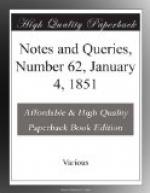CUDYN GWYN.
Church of St. Saviour, Canterbury (Vol. ii., p. 478.).—I would submit to Sir Henry Ellis, that the church at Canterbury which is mentioned in the charter from which he quotes, is termed Mater et Domina, not on account of its greater antiquity, but by reason of its superior dignity; and that the church referred to is clearly the cathedral church. The charter is one of confirmation of privileges: it proceeded upon the “admonition of the most pious Archbishop Liuingus,” and “upon consideration of the liberties of the monasteries situated within Kent.” It granted that the church of the Saviour (ecclesia Salvatoris), situated in Canterbury, the mother and lady of all the churches in the kingdom of England, should be free, and that no one should have any right therein save the archbishop and the monks there serving God. The whole tenor of the charter, and more particularly the words last referred to, “archiepiscopum et monachos ibidem deo famulantes,” seem to me to indicate the cathedral church, and no other. If it be inquired, How then came it to pass that the cathedral, which is dedicated to Christ, should be described as ecclesia Salvatoris? some persons may answer, that this apparent blunder is an indication that the charter is not genuine. But that is not my opinion. The charter is printed from the register of the cathedral, and if it had been forged by the monks, they would scarcely have made a mistake upon such a point as the dedication of their own church. Coming out of such custody, the unusual designation, as we now esteem it, seems clear proof that the charter is genuine. I would suggest, either that the cathedral, or a part of it, was really dedicated to the Saviour; or that the words are to be understood not as indicating the church of St. Saviour, but the church of the Saviour, that is, Christ.
JOHN BRUCE.
Pope Ganganelli (Vol. ii., p. 464.).—In reply to the inquiry of CEPHAS, I give you the following anecdote, in the words of the Rev. Dr. Kirk, of Lichfield, who still survives (and long may he yet survive!) to bear testimony to its correctness:—




